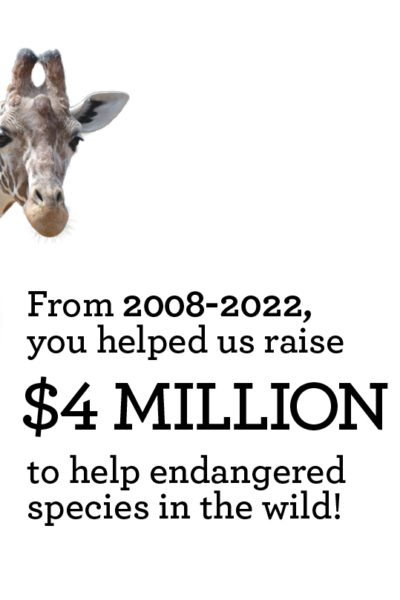


Cheyenne Mountain Zoo and its guests and members are celebrating a huge milestone, having raised $4 million for wildlife and wild places, since the Zoo’s Quarters for Conservation (Q4C) program launched in 2008.
Every visitor to the Zoo receives three “quarter” tokens representing the 75¢ Q4C allocation from their admission fee. They can then show support for the legacy projects they love by placing their tokens in the corresponding slots in the Q4C kiosks.
In recent years, CMZoo staff have traveled to Africa, Central America, Indonesia and the prairies of Wyoming and Colorado, to lend their expertise in support of our partner organizations around the world. Our guests’ support is far-reaching. It benefits the organizations we support, their teams, local communities and the animals they protect. It also enriches the lives of our teammates who return to the Zoo to share new experiences and reignited passions for protecting wildlife and wild places.
Before launching Q4C in 2008, CMZoo was supporting conservation, but at a fraction of what is possible now. As more people visit the Zoo each year, we can contribute more money to conservation. In the past few years, CMZoo has collected about half a million dollars per year through Q4C. In the Zoo’s 2021 fiscal year, guests contributed nearly three-quarters of a million dollars. The Zoo’s membership and EdVenture programs also contribute to conservation. CMZoo’s current beneficiary species include giraffe, Panama frogs, orangutans, black-footed ferrets, African elephants and rhinos, Wyoming toads and African vultures.
About Our Current Q4C Legacy Projects
Q4C beneficiary species truly run the gamut, from 18-foot-tall giraffe in Africa, to tiny toads in Wyoming.

Q4C helps support a multi-organizational giraffe conservation project in Uganda, called Operation Twiga. Operation Twiga began in 2016 to give giraffe a better chance of survival by establishing new populations of giraffe in safe habitats, in partnership with Giraffe Conservation Foundation, Uganda Wildlife Authority and others. Operation Twiga V (2020) was a continuation of Operation Twiga IV (2019), which CMZoo staff attended to assist with anesthesia and moving the giraffe. Both giraffe translocations contributed to populations in Pian Upe Wildlife Reserve, an historic habitat in Uganda where giraffe hadn’t existed for more than 20 years. Ongoing Q4C funding supports the teams who continue to monitor and protect these newly established wild populations.
Q4C also funds CMZoo’s on-site breeding programs for black-footed ferrets and Wyoming toads. These endangered prairie species were declared extinct in the wild in the 1980s and early 1990s, and are only around today because of decades of recovery efforts from zoos and partner organizations. 18 ferret kits were born at CMZoo in the 2021 breeding season, and six juveniles were released into their natural habitat by CMZoo staff and wildlife partners in the fall. In Spring and Summer 2021, CMZoo staff released 228 yearling “headstart” toads, 58 metamorph toadlets, and 5,338 tadpoles to their native habitat in Wyoming. Summer 2022 breed-and-release efforts are well underway, and later this year, more of these vital species will join their relatives in the wild, thanks to CMZoo guests’ support.

Wyoming toads are symbolic of so many amphibian species in decline all over the world, including Panamanian frogs, which also receive support thanks to Q4C funds and frontline CMZoo staff support. In February 2019, three CMZoo staff members went to Panama to assist the Panama Amphibian Rescue and Conservation Project by remodifying two feeder insect pods into frog pods. For this 10-day trip, the goal was to set up two shipping containers to house and breed approximately 450 additional frogs brought in from El Valle Amphibian Conservation Center, and later released. This involved disinfecting the shipping containers, painting, installing plumbing and water filtration, assembling racks, and drilling and prepping tanks.
CMZoo’s work to save habitats for orangutans through advocacy for sustainable palm oil production is also largely supported by Q4C. Thanks to that financial support, CMZoo’s sustainable palm oil team consults staff at other conservation organizations on starting their own palm oil programs. The CMZoo sustainable palm oil team continued to focus on international work through the World Association of Zoos and Aquariums (WAZA). The team was instrumental in the creation of the WAZA Short Guide on Sustainable Palm Oil and the sustainable palm oil shopping app, which allows shoppers to scan the barcodes of items to learn whether producers have committed to using sustainable palm oil.

Through Q4C, CMZoo also supports a conservation partner called Tsavo Trust – an organization in Kenya that works to protect the last of the big tuskers, which are African elephants with tusks weighing more than 100 pounds. CMZoo’s funds helped Tsavo Trust build permanent housing that allowed staff to live on the land where these critically endangered giants live. It also paid for pilot hours of frontline aerial surveillance that protects rhinos and elephants from poachers seeking their ivory.
The seventh Q4C legacy partner is VulPro – protectors of African vultures. The dedicated staff at VulPro, in South Africa, save vultures who have been injured as wild birds, and rehabilitates them to release. Those that are too injured to survive in the wild find a permanent home at VulPro.
For more information about these projects and Quarters for Conservation, visit cmzoo.org/conservation.
About Cheyenne Mountain Zoo
Cheyenne Mountain Zoological Society was founded in 1926. Today, Cheyenne Mountain Zoo, America’s mountain Zoo, offers comprehensive education programs, exciting conservation efforts and truly fantastic animal experiences. In 2021, Cheyenne Mountain Zoo was voted #4 Best Zoo in North America and CMZoo’s Rocky Mountain Wild was named #3 Best Zoo Exhibit in North America by USA TODAY 10Best Readers’ Choice Awards. It is Cheyenne Mountain Zoo’s goal to help guests fall in love with animals and nature, and take action to protect them. Of the 242 zoos and aquariums accredited by the Association of Zoos and Aquariums (AZA), Cheyenne Mountain Zoo is one of just a few operating without tax support. Cheyenne Mountain Zoo depends on admissions, membership dues, special event attendance and donations for funding.
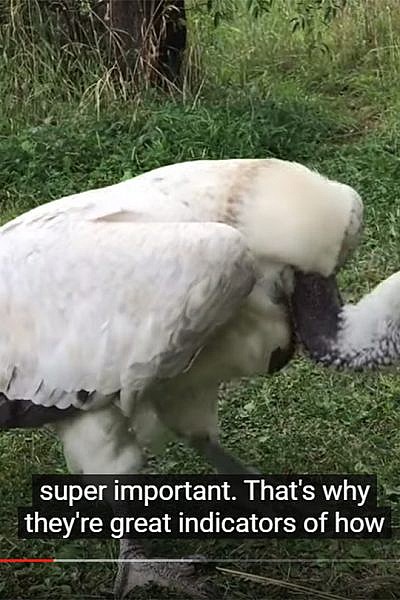

Happy International Vulture Awareness Day! Today, keepers Brooke and Michelle are spending time with Godric and Hedwig, our Cape griffon vultures, and Nesher, our Eurasian griffon vulture. Cape Griffon vultures are endangered with declining populations, but Eurasian Griffon vultures are of least concern and are increasing in the wild. Vultures are extremely important parts of their ecosystems, and serve as an indicator of the health of the environment below them. Measuring the health of vultures is a great way to measure the overall health of the food chain below them.
Many of the challenges that vultures face in the wild are man-made. Accidental power line collisions are a major issue for these birds. Poachers will also sometimes poison the meat of illegal kills to prevent vultures from flying above the carcasses and revealing their location to rangers. Loss of habitat is also causing a decline in these powerful birds, as it means fewer resources for these birds to live off of.
While these dangers are man-made. not all human intervention is bad for these birds. We are proud that Cheyenne Mountain Zoo’s guests help fund the operations of VulPro through Quarters for Conservation, which is funded by your 75¢ contribution every time you visit the Zoo. VulPro is a South African-based conservation program that works to save Africa’s vultures through rehabilitation efforts, captive breeding programs, research and education.
Since November 2020, VulPro has rescued 59 vultures, most of which were victims of power line collisions and starvation. One of their rising concerns is the impact of wind farms on vulture populations, as they are beginning to see more vultures and raptors injured or killed by collisions with turbines. One especially memorable rescue occurred in May this year, when an African white-backed vulture had its head and beak stuck in a piece of old pvc pipe. When the VulPro team rescued the bird, he was malnourished and dehydrated, and his tongue was damaged where the pipe had cut into it. The vulture stayed at the Vulpro facility until it recovered, and was released back into the wild on June 1.
VulPro’s hope is to inspire people to protect these iconic species. Thank you for celebrating International Vulture Awareness Day with us at Cheyenne Mountain Zoo, where every visit is conservation in action.
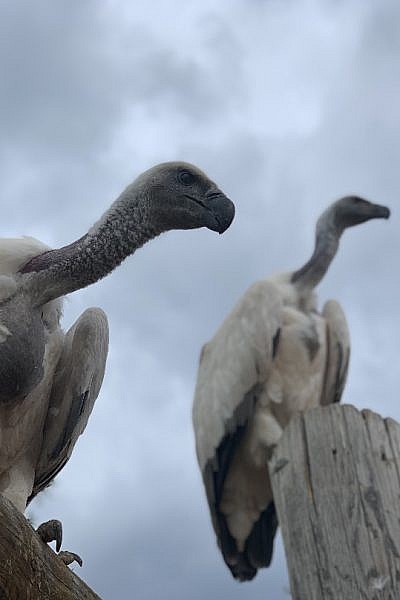


The Cheyenne Mountain Zoo family is getting excited for International Vulture Awareness Day (IVAD) on Saturday, September 5, 2020 – almost as excited as Godric, Hedwig and Nesher, CMZoo’s three vultures, get for training time.
When 6-year-old male African cape vulture, Godric, and 14-year-old female African cape vulture, Hedwig, see their keepers approaching, they come running. With their enormous white wings held back in the charging position and their impressive beaks aimed low and straight forward, the raptors move at an intimidating pace with little regard for any obstacles – or guineafowl – in their way. Nesher, a 29-year-old Eurasian griffon vulture, has a more reserved approach, waiting receptively by the perching for her keepers. It hasn’t always been this way for the instinctively cautious birds, but their keepers have been working hard to earn the vultures’ trust – and it’s benefitting the vultures, the keepers, our guests and vultures in the wild.
“We’ve always interacted with them, but until recently, they wouldn’t have been comfortable with us sitting this close,” said African Rift Valley keeper Philip Waugh, as he perched on a rock about two feet from Godric. “We’ve been making opportunities to spend more time with them and to reward them for being calm with us while we calmly sit with them. We all have our stations, both keepers and birds. We just hang out together on their turf by the vulture perches, and that’s helping build our relationship of trust.”
At first, the keepers would go and find the vultures for their three-times-weekly feedings. Because they eat so infrequently, training and building relationships requires a lot more patience than it normally might with animals that eat multiple times daily. But the patience is paying off.
“Before, we could tell they weren’t huge fans of sharing their space with us, but now they get excited for training, “said Waugh. “They have incredible eyesight, so they can recognize us all the way from the giraffe boardwalk, and they start sprinting down the Safari Trail to our meeting point. They beat us there nearly every time.”
Making sure these interactions are positive for the vultures is important because keepers can provide frequent visual health checks and expand their training. It also helps keepers foster special connections between guests and the vultures, which ultimately benefits their wild counterparts.
“If you’ve ever been up-close to a bird with an eight-foot wingspan, you know how impressive it is,” said Waugh. “Just seeing them eye-to-eye makes an impact. Our goal is to find more ways for our guests to connect with them. We know that once people meet them, our vultures will inspire our guests to learn more about this amazing species and its struggles, then take action to protect their wild relatives.”
When COVID-19 isn’t an issue, the Zoo hosts IVAD activities at the Zoo throughout the day to help guests learn more about vultures. This year, to prevent large crowds from gathering during the pandemic, the team will post fun and educational materials on the Zoo’s social media pages.
Even though the Zoo can’t offer in-person IVAD activities on September 5, just by visiting the Zoo, guests are helping CMZoo protect and advocate for wild vultures. 75¢ from every Zoo admission goes to conservation through the Quarters for Conservation (Q4C) program, which has raised more than $3 million since it started in 2008.
One of CMZoo’s Q4C beneficiaries is VulPro, a nonprofit organization in South Africa working to save endangered African vultures through breeding, rehabilitation, research and education. Vultures, positioned at the top of the food chain, are an indicator of the health of the environment below them – and dependent for their survival on a healthy environment. Every visit to the Zoo supports this organization on the frontlines of vulture conservation.
“Vultures are nature’s clean-up crew,” said Waugh. “They clean up carcasses that other animals can’t. They stop the spread of disease by consuming decaying meat and bones. Thanks to their strong stomach acids, they can consume deadly bacteria that could pose a threat to animals and humans. They do so much more, but the most basic explanation is that they make the world a lot prettier, safer and a lot less smelly.”
Vultures’ adaptations help them make quick work of the world’s messiest clean-ups. Their iconic bald heads prevent bacteria from sticking to their skin, an important trait for such a mobile animal. Preventing the spread of bacteria is key for their well-being, which is why some vulture species urinate on their own legs, killing carcass bacteria in the process. Their nares, or nostrils, drip a salty liquid that helps flush out their sinuses, removing any rogue pieces of meat that may have gone up their noses during ravenous eating. Just because they’re built for devouring dead animals doesn’t mean they’re unhygienic, though. They bathe regularly, both in the water and the sun. The UV rays from the sun kill any pathogens in their feathers after feeding.
“My favorite time to see them is in the mornings when they’re open-winged, sunning themselves in the early light,” said Waugh. “I love watching them interact with each other. They all have such unique personalities.”
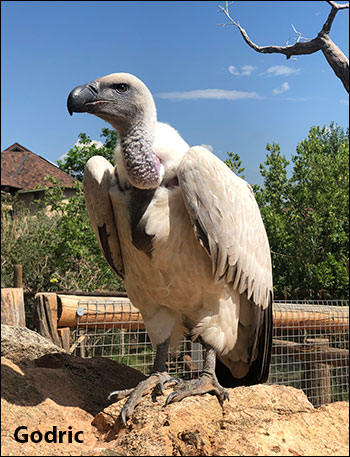
Godric, Nesher and Hedwig interact with toys, keepers, food and each other in distinct ways.
“Godric and Hedwig are hilarious,” said Waugh. “They’re both African cape vultures, but they’re not related. Still, they act like siblings a lot of the time. They explore new enrichment items together and if one vulture is nervous or excited, the other usually rushes to join in, whether or not they know what’s going on. They will also bicker over food or a good sunny spot, but that’s normal for vultures. Godric seems to be the most eager to approach us, but Hedwig is gaining confidence.”
Nesher, whose keepers describe her as the ‘queen bee,’ is the most confident and the oldest, at 29 years old. She prefers to spend most of her time by the vulture perching, but also has a bit of an adventurous bone.
“She recently commandeered the Okapi yard,” said Brooke Powell, African Rift Valley keeper who works with Philip and the vultures. “She also frequently ventures into the giraffe yard. Nothing scares her. This species is naturally pretty avoidant of new things, but she’s the opposite of that. She’s really bold and brave. Not a lot phases her, and she has the coolest vocalizations when I feed her and she’s excited.”
Vultures communicate about food, territory and potential threats in the wild by vocalizing.
“When Nesher vocalizes, she usually runs toward us full speed,” said Powell. “It’s really impressive. People can hear her from the giraffe boardwalk all the way across the yard, which is cool because we see people getting curious about the vultures and then come to visit them.”
Next time you’re at CMZoo, look down from the African Rift Valley ramp up to Encounter Africa, where the vultures are often perched. Supporting CMZoo is an easy way to support vulture conservation through its longstanding partnership with VulPro. The Zoo has contributed more than $90,000 to VulPro over the years.
“After VulPro rescues and rehabs vultures, they’re released into the wild, which is super important because they’re so endangered,” said Waugh. “VulPro rangers rescue vultures that have been poisoned by poachers – one of wild vultures’ biggest threats.”
The carcasses of poached animals attract vultures. A large group of vultures is easier to spot than a deceased animal, so their presence helps rangers find poached animals. Poachers caught onto this pattern, and started poisoning the carcasses to kill the vultures that eat them, thus hiding their misdeeds. Supporting VulPro’s ongoing rescue, rehabilitation and release efforts means more wild vultures can breed and thrive in the wild.
There are several ways to protect vultures here in Colorado, too. Turkey vultures are native to our region, and are just as important to our local ecosystems as African vultures are in theirs.
Pick up trash to help vultures avoid ingesting dangerous materials. Avoid using poisons for pest control or weed killer. Report roadkill to local authorities, so vultures aren’t encouraged to dine in the middle of a busy road or highway. Slow down when you see roadkill, so vultures and other scavengers have time to get out of the way. Use lead-free fishing tackle and ammunition. Dispose of fishing line properly.
To learn more about vultures, and how you can help save this incredible species, mark your calendars for Saturday, September 5, when CMZoo will share a video of up-close interactions with the vulture trio on Facebook and YouTube.
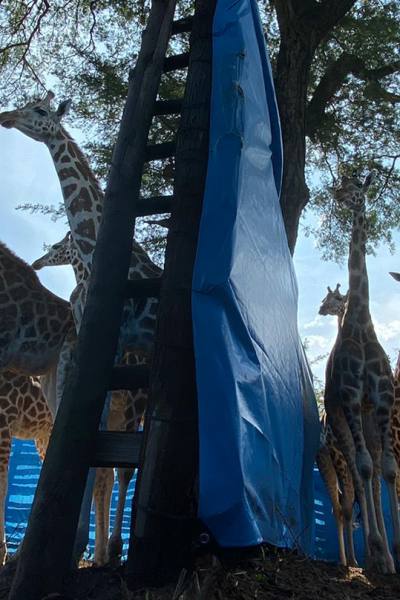

Every visit to the Zoo is conservation in action. Cheyenne Mountain Zoo and its guests and members are celebrating a huge milestone, having raised $3 million since the Zoo’s Quarters for Conservation program launched in 2008.

Quarters for Conservation, or Q4C, is the Zoo’s largest fundraiser for field conservation. It actively engages visitors and staff in supporting long-term projects championed by the Zoo. Known as legacy projects, these currently include biodiversity conservation on behalf of giraffe, Panama frogs, orangutans, black-footed ferrets, African elephants and rhinos, Wyoming toads and African vultures. Every visitor to the Zoo receives three “quarter” tokens representing the 75¢ Q4C allocation from their admission fee. They can then select the legacy projects they would like to support by placing their tokens in the corresponding slots in the Q4C kiosks. The kiosks record the number of tokens, so it’s easy to see how popular each project is.
“Our guests have helped us save animals from extinction simply by visiting the Zoo,” said Dr. Liza Dadone, vice president of mission and programs. “Three million dollars in conservation support is huge – and we want to thank our guests and members. Through this program, they are directly empowered to make a difference, and they did. It’s an example that no matter how small, when we all work together, we can change the world for the better.”
One of the projects that CMZoo recently supported and participated in on the front lines, is Operation Twiga. In November 2019, with financial support from Q4C, CMZoo staff traveled to Uganda for Operation Twiga IV. They helped transport 15 critically endangered Nubian giraffe to a safer home within Uganda, where their species has another chance at survival. As part of this project, CMZoo vet staff helped to collect important medical data for an ongoing study to help giraffe in their natural habitat and those in human care.
“We haven’t been involved in giraffe conservation that long, so this Q4c funding since 2008 has allowed us to really step up and take a leading role among Zoos in the past few years,” said Dr. Dadone. “It’s raised visibility in our Zoo community that giraffe populations aren’t safe. People see a large herd of giraffe here at the Zoo, and I think it’s easy to assume that they’re still doing okay across their native lands in Africa, but that’s no longer a reality. Giraffe are locally extinct in seven countries in Africa. Our Zoo, including our supportive community, is committed to ensuring that incredible animals like giraffe are around for the next generation.”
Q4C beneficiary species truly run the gamut, from 18-foot-tall giraffe in Africa, to tiny toads from Wyoming.

“Another program I’m especially proud of is our Wyoming toad breed and release program,” said Dr. Dadone. “This species was once thought to be extinct in the wild. The only reason they exist in the wild today is because of our work and our team’s collaborations with other institutions. Some might think Wyoming toads aren’t as cute as a baby giraffe, but the toadlets are really adorable and are critical to our ecosystem and to ensuring we have a viable wildlife population in our own backyard. The research that we’ve done on headstarting [raising the toads to adulthood in the Zoo and then releasing them] and their nutrition has really improved the overall health of the last few generations of the Wyoming toad, which gives them an advantage when they are released into the wild. We’re continuing to evaluate our best practices and have an even better chance at saving this species long-term.”
Wyoming toads are symbolic of so many amphibian species in decline all over the world, including Panamanian frogs, which also receive support thanks to Q4C funds and frontline CMZoo staff support. In February 2019, three CMZoo staff members went to Panama to assist the Panama Amphibian Rescue and Conservation Project by remodifying two feeder insect pods into frog pods. For this 10-day trip, the goal was to set up two shipping containers to house and breed approximately 450 additional frogs brought in from El Valle Amphibian Conservation Center, and later released. This involved disinfecting the shipping containers, painting, installing plumbing and water filtration, assembling racks, and drilling and prepping tanks.

Q4C supports an in-house breed and release program for black-footed ferrets, as well. Since 1991, when CMZoo began breeding black-footed ferrets, 567 kits have been born. Roughly half of those kits are released into the wild while the others continue breeding at CMZoo and other facilities who support this recovery effort and the Species Survival Plan. This ongoing recovery effort supports the population of black-footed ferrets, who were once thought to be extinct, and which are vital to the prairie ecosystem in Wyoming.
CMZoo’s work to save habitats for orangutans through advocacy for sustainable palm oil production is largely supported by Q4C. Thanks to that financial support, CMZoo’s sustainable palm oil team consults staff at other conservation organizations on starting their own palm oil programs and recently attended the Roundtable on Sustainable Palm Oil’s (RSPO) annual conference in Thailand to represent CMZoo in the RSPO’s proceedings. Those proceedings directly impact the ways companies that use palm oil can help preserving wild lands for orangutans and other species.
Through Q4C, CMZoo also supports a conservation partner called Tsavo Trust – an organization in Kenya that works to protect the last of the big tuskers, which are African elephants with tusks weighing more than 100 pounds. CMZoo’s funds helped Tsavo Trust build permanent housing that allowed staff to live on the land where these critically endangered giants live. It also paid for pilot hours – frontline aerial surveillance that protects rhinos and elephants from poachers seeking their ivory.
The seventh Q4C legacy partner is VulPro – protectors of African vultures. The dedicated staff at VulPro, in South Africa, save vultures who have been injured as wild birds, and rehabilitates them to release. Those that are too injured to survive in the wild find a permanent home at VulPro.
Before launching Q4C in 2008, CMZoo was supporting conservation, but at a fraction of what is possible now. In the past few years, CMZoo has collected about half a million dollars per year through Q4C. Even with our three-month COVID-19 closure this year, the Zoo was able to hit this substantial $3 million milestone as expected.
“Small change pooled together makes a big difference,” said Dr. Dadone. “Thanks to our guests and members, we have been able to support this amazing frontline work. When we work together, we can make a positive difference for our world.”
In addition to contributions from admissions to every Zoo visit and special event ticket, $2.50 from each individual plus membership, and $5 from each family or higher-level membership, is allocated to Q4C. EdVenture and Animal department programs also contribute to the cause.
For more information about these projects and Quarters for Conservation, visit cmzoo.org/conservation.
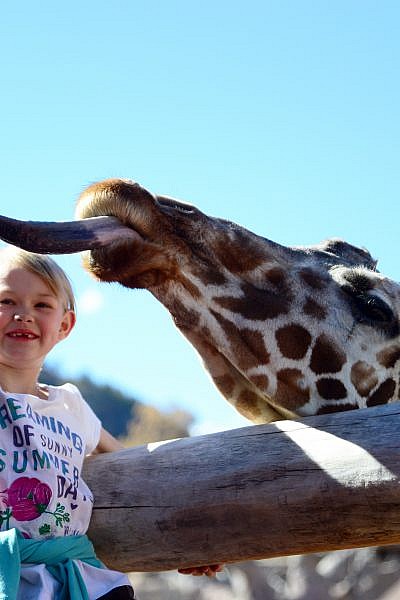

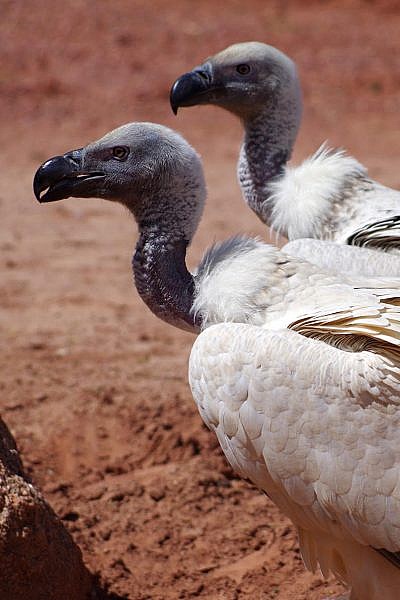

When you think of vultures, chances are you don’t picture heroic, beacons of hope contributing to a strong and healthy ecosystem. That’s because vultures sometimes get a bad rap in our society, often depicted negatively due to their scavenger status. Cheyenne Mountain Zoo has been supporting vulture conservation in various ways since 2009, including currently as a Quarters for Conservation (Q4C) animal beneficiary. Senior Lead Keeper, Jenyva Fox, has been hard at work changing the way guests perceive and understand vultures – in part by organizing International Vulture Awareness Day (IVAD), celebrated annually at CMZoo, on the first Saturday in September. This year, vulture keepers will host activities from 10 a.m. to 2 p.m. on Saturday, Sept. 7.
“The foods that vultures eat, including decaying carcasses, may not be the most appetizing to us, but they are still very important members of the animal kingdom,” said Fox. “The message we try to share with guests is that vultures are the MVPs of keeping our environment clean and safe from the spread of diseases.”
This message is a bit easier to convey when you have three charismatic and interesting vultures to serve as animal ambassadors, helping to educate thousands of guests every year. Fox, along with a team of other keepers, cares for two African Cape vultures, Godric and Hedwig, and Nesher, a Eurasian griffon vulture.
Situated atop new perching that overlooks African Rift Valley, these three raptors survey both guests and animals alike during the warm months of the year. Godric, a 5-year-old male, is curious and friendly.
“Godric loves to swoop into the zebra yard during training sessions, just to check in on the keepers and see what we’re up to,” Fox said. “He’s developed a real bond with us since he arrived almost two years ago.”
Fox says that Godric has helped fellow Cape vulture, Hedwig, to build more confidence, making her braver and more outgoing.
“Hedwig is known for her confidence in the giraffe yard,” Fox said. “She’ll walk among the giraffe, bathe in the waterhole and has even found a great perching spot on top of the giraffe statue in the main yard.”
Nearing 30 years old, Nesher, on the other hand, prefers her routine, opting instead to hang back along the Safari Trail, in a more private location below the Zoo’s main road in African Rift Valley.
“Nesher was hand-raised by vulture conservationists in Israel, so she feels right at home with people,” Fox said. “This could explain why her favorite pastime is people-watching. If you want to see Nesher, your best bet is to walk along the new stroller ramp and look down. You’ll most likely find her looking up at you from that rocky, shaded space.”
Developing connections with Godric, Hedwig or Nesher makes it easier for guests to learn about the contributions vultures make in the natural world. These misunderstood and disparaged birds are nature’s clean-up crew, largely helpful in preventing the spread of disease. Their unique appearance and adaptations serve a greater purpose.
Their iconic bald heads actually prevent bacteria from sticking to their skin, an important adaptation for such a mobile animal. Preventing the spread of bacteria is key when you’re a vulture, which is why some species urinate on their own legs, killing carcass bacteria in the process. No need to panic if you get up close to a vulture, though, because they also bathe regularly – both in the water and the sun. The UV rays from the sun kill the pathogens in their feathers after feeding.
“The thing that makes them the most amazing is that they have very strong stomach acids that kill diseases and bacteria in the food they eat,” said Fox. “This is why they don’t get sick like other scavengers could.”
Sadly, all of these physiological tools aren’t enough to overcome poisoning, which is the species’ largest threat to survival. Misconceptions about vultures, such as being mystical, fortune-telling beings, are partially accountable for vulture poisonings. Ironically, it’s their very scavenger nature that most often leads to their death. Vultures’ very presence points rangers in the direction of animals that have recently been poached. In an effort to hide their misdoings, poachers will poison the carcasses to try and stave off the rangers.
Through the eyes of a conservationist like Fox, saving vultures is closely linked to saving several other endangered or critically endangered species. Efforts to protect these animals in the wild are, therefore, especially vital. This is why CMZoo has joined forces with the AZA African Vulture SAFE (Saving Animals From Extinction) program and the Vulture Conservation Program, commonly known as VulPro.

SAFE programs are made up of Association of Zoos and Aquariums (AZA)-accredited member organizations that help facilitate and guide united conservation efforts for several endangered species, including elephants, giraffe and orangutans. The vulture SAFE program hit the ground running when it got its start in 2018 and hasn’t stopped since. In comparison to other SAFE programs, the African vulture effort is unique in that it works to conserve six species, as opposed to a singular one. This is because all six species of vulture face very similar threats to survival, so strategies that help one species can also help the other five.
VulPro, a field partner of the vulture SAFE program, helps address captive breeding and reintroduction of vultures, as well as the rehabilitation of injured or poisoned vultures. The Zoo has supported vulture conservation by supporting VulPro for over a decade now, contributing nearly $90,000 to the South African non-profit over the years.
Before becoming a member of the African Vulture SAFE steering committee, Fox was heavily involved in raising awareness for these often misunderstood birds. One way she built excitement for vultures was by helping to establish International Vulture Awareness Day (IVAD), and bring the program to Cheyenne Mountain Zoo. The international celebration began in 2009, and has been celebrated right here in Colorado Springs ever since.
“We started celebrating IVAD before many other animal celebration days were in the works,” recalled Fox. “IVAD was around before World Lion Day or World Elephant Day. When the celebration began, the idea of having one day a year focused on one animal’s conservation was relatively new to the Zoo world. IVAD became a necessity because these birds were in trouble, and we didn’t (and still don’t) have a beloved children’s character or even a well-known or respected animal at the helm. People weren’t as interested in saving them.”
From the beginning, Fox knew this would be an uphill battle. Luckily, the mountainous landscape at the Zoo prepared her for such a challenge. She decided the best way to get people interested in vulture conservation was to lean into the preconceived notions about vultures that people already had. IVAD activities, such as making “vulture vomit” and hosting “scavenger” hunts quickly became crowd favorites, especially among the younger visitors.
“Taking vultures’ traits and characteristics and making them into fun activities is a way to grow appreciation for vultures and what they do for us,” Fox said. “Every September, I’m just amazed at how many kids are excited to learn about vultures. Each year, people are more aware, and actively look for them in the exhibit. That’s something that never used to happen. I think part of what’s spurred this increased interest is their inclusion in the Q4C kiosks down at the admissions plaza. It warms my heart to think that we’ve been able to inspire others to care about and want to protect vultures.”
This year, Fox and other keepers will host the 11th annual vulture celebration on Saturday, September 7 from 10 a.m. to 2 p.m. in African Rift Valley and Encounter Africa. Guests can expect the same hands-on activities they have grown to know and love, like vomit-making, stomach juice experiments and condor “surgery.” Our own vultures, Godric, Hedwig and Nesher, will be there, of course, ready to leave kids of all ages in awe of the many wonders vultures provide our ecosystem.
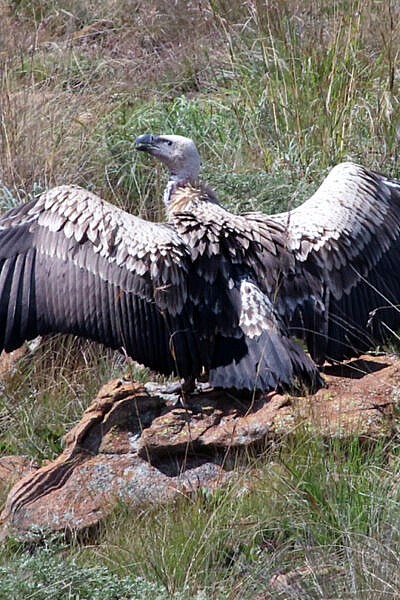

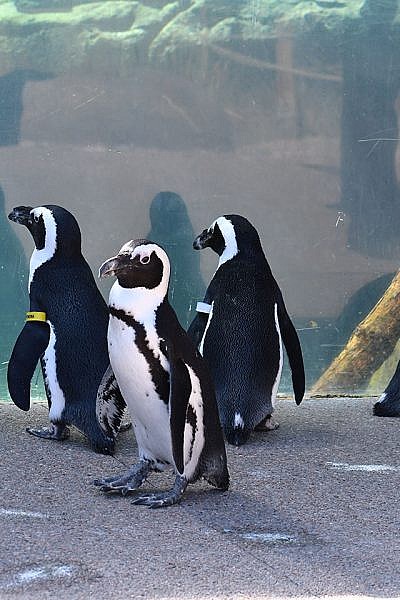

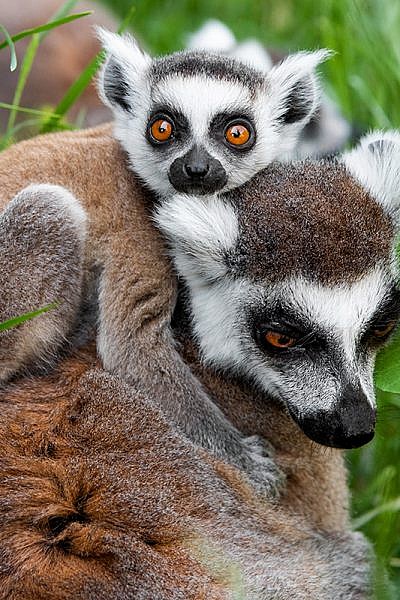

Foster any animal and you’ll help Cheyenne Mountain Zoo continue to provide outstanding care. Whether given as a gift or used to celebrate a favorite species, symbolic adoptions come with a variety of benefits only adoptive parents can enjoy.
Ways to adopt your favorites:
- Digital Adoption – ($35) choose any Zoo animal from the full list provided below.
- Group Adoption – ($35+) pick a herd, chatter or family for your classroom or group, offered for certain featured animals below.
- Traditional Adoption – ($50+) choose any Zoo animal from the full list provided below.
- Wild Adopt Gift Packages – ($65) includes a cuddly plush, offered for many featured animals below.
- Gift any Adoption – ($35+) gifting any adoption is offered during check-out.